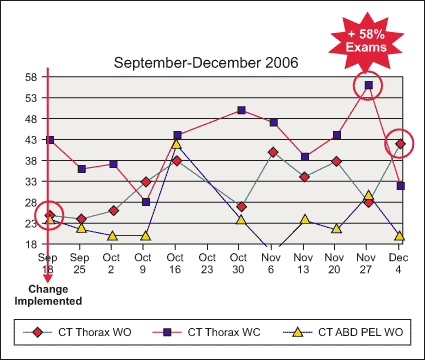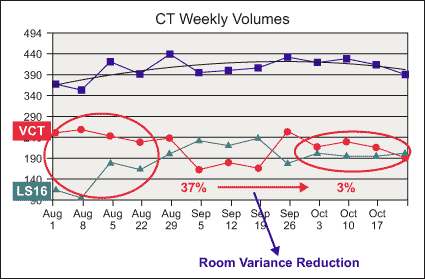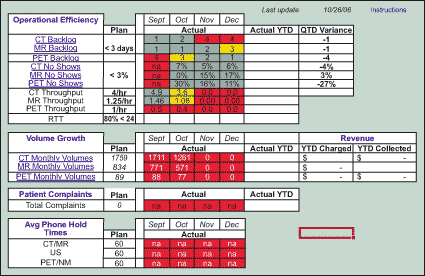
Moving patients efficiently through the system can become a challenge for hospitals and imaging centers, especially as demand increases. This was the case for the radiology department at Watson Clinic in Lakeland, Florida, USA. A growing backlog of appointments – particularly in computed tomography (CT) scans – had begun to impact timely access to services.
While delays can be common in radiology, there is rarely a single common cause – instead there may be multiple factors slowing the system down and adversely impacting patient throughput. Often the answers are not as obvious or intuitive as they may appear on the surface.
The key is to employ a data-driven process to identify the bottlenecks, reduce or eliminate them, and introduce a sustainable solution.
In 2006, Watson Clinic, one of the largest medical clinics in the southeastern United States with about 800,000 patient visits each year, began to analyze specific drivers behind the bottlenecks using Lean Six Sigma.
Evaluating and Streamlining Services
An initial assessment examined three areas for potential improvement: CT, positron emission tomography (PET) imaging and magnetic resonance imaging (MRI). While there were opportunities in all three, CT had a larger backlog and became the primary area of focus. The goals and scope of the project were clearly defined. The project team sought to increase CT capacity, improve patient throughput and make sure exams would consistently start on time. The team also wanted to develop relevant metrics and dashboards that would enable it to monitor improvement on an ongoing basis.
The team began by gathering information from a variety of sources and departments to determine the current state of patient flow. Accurately measuring the existing level of throughput was an important first step in the process. This provided a reliable baseline to compare against any improvements put in place during the course of the project.
Findings from the measurement phase of the project included the following:
- Patient backlog for CT was at four days.
- Room schedule varied by up to 40 percent a day.
- Patient throughput was at two per hour per CT.
- Half of the exams were starting 15 minutes late or later.

Armed with valid data analysis and input from key stakeholders, the team began developing solutions. To reduce systemic waste and eliminate unnecessary process steps, the team applied Lean techniques such as value stream mapping. Team members also followed the Six Sigma DMAIC (Define, Measure, Analyze, Improve, Control) approach as a structured, evidence-based method for analyzing and adjusting processes. During the Analyze and Improve phases, the team had Work-out sessions that help by bringing together the people closest to a process, empowering them and introducing them to specific techniques for rapid decision making. For the CT project at Watson Clinic, the team was able to successfully leverage involvement from a variety of people in the department to focus on the issues that had been identified and brainstorm specific solutions.
Within a relatively short period, (the entire project took just 10 weeks), the team implemented a number of positive changes including a reduction in slot times for eight exams to 20 minutes, and creating a block schedule to handle add-on appointments. The team also addressed issues with incorrect orders, standardized the room scheduling process and developed appointment reminder scripts.
The approach to managing change was very effective, according to Richard Gould, Watson’s clinical director.

Measuring and Maintaining Change
Using a combination of Lean and Six Sigma, Watson Clinic saw measurable improvement in capacity. The clinic was able to reduce its CT backlog from four days to one. It increased CT capacity by 40 percent. It improve patient throughout to 3.3 per hour per CT. And it improve exam start time so that 90 percent of exams start on time.
The team also implemented a comprehensive dashboard to monitor eight operational and financial metrics on a monthly basis.

CT Project Results
- CT backlog reduced to one day
- 90 percent of exams start on time
- 40 percent increase in CT capacity
- Dashboard implemented
- Increased outpatient volumes to 3.3 patients/hour
- Financial potential ~ $674,000 over one year
“With the changes in place, we’re now able to do same day or next day scanning, and this has opened up access to additional services for patients,” Gould said.
Being able to function at peak efficiency is essential for Watson Clinic’s radiology department, since it provides approximately 200,000 exams each year and has experienced significant growth since 2001. The department has indicated it is continuing to expand its imaging capacity due to the adjustments that were made.
“With regard to CT, we’ve probably seen 25 percent growth between 2006 and 2007,” said Gould. “PET has grown by about 30 percent over the same time period…. The important thing is that we’re staying on track with our achievements. So often you put changes in place and then before you know it, the same issues start to creep back into the system. We believe we can avoid that scenario by taking an approach that focuses not just on short-term improvements, but also on monitoring and maintaining the results over time.”